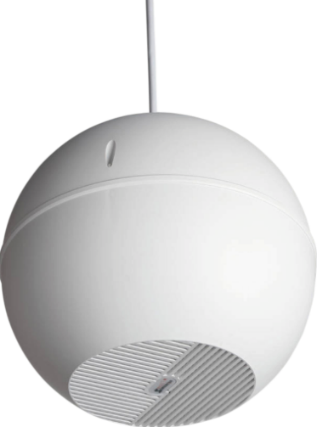Line-Matching Transformer Design Considerations : Constant voltage speaker systems like those discussed in part one can be built with a wide variety of loudspeaker designs, all of which employ line-matching transformers to step the voltage down at the speaker. Below are some examples of loudspeaker designs used in distributed audio applications.
Loudspeakers
A typical example of a loudspeaker used in a hotel or other large building would be a ceiling speaker. This is simply a loudspeaker designed for mounting into the ceiling of the room or corridor.


There are many different loudspeakers designed for mounting on walls, for outdoor yards, for hanging from ceilings, etc.
Other examples of loudspeaker designs
Wall Mounting Speakers

Ceiling Mounting Speakers


Recessed into Ceiling

What is important for a line-matching transformer?
Frequency Range
The transformer must be able to pass through all the frequencies without attenuating or distorting the audio signal.
The typical range of frequencies for audio is 20 Hz to 20 kHz, and a common method of defining the frequency response of a transformer is to specify lower and upper 3 dB points. This means the frequencies at which the transformer will only pass through 50% of the power, or -3 dB.

If we take an extreme example of a “Horn Speaker,” where sound quality is typically very poor, the typical frequency response of the loudspeaker itself may be:

As shown above, the maximum Sound Pressure Level (SPL) is 110 dB, so the orange line represents 3 dB below that. We can see these -3 dB points give a frequency range of around 1 kHz to 2.5 kHz only, so this actual horn loudspeaker will not reproduce all frequencies from 20 Hz to 20 kHz reliably, and the transformer needed in this instance would only need a similar narrow bandwidth, or narrow frequency response.
For higher quality sound transmission, the transformers used on each end of the line must have a good frequency response. A typical specification for a high-quality toroidal line matching transformer would be 40 Hz to 15 kHz.
To achieve this wide frequency range, we must consider the transformer performance at both low frequency and high frequency.
Low Frequency
At the low-frequency end, we must design the transformer to avoid saturation at the lowest frequencies in use and choose suitable core dimensions for the application.
High Frequency
At the high-frequency end, we must design the transformer with low leakage inductance and higher interwinding capacitance. In most cases the input and output windings must be interleaved to some extent to achieve this lower leakage inductance. This may be as simple as splitting the primary winding into two halves and “sandwiching” the secondary winding between these halves, including insulation as needed between input and output circuits.
Instead of winding the primary and the secondary as per a typical mains power transformer, we may wind half of the primary, insulate, then the secondary, insulate again and then the remaining half of the primary.
This means a better high-frequency response, but depending on the customer’s specification, further interleaving may be needed:
- Prim : Sec : Prim
- Prim : Sec : Prim : Sec
- Prim : Sec : Prim : Sec : Prim
- Prim : Sec : Prim : Sec : Prim : Sec ……. Etc
Electrical Calculations: Watts, Volts, Amps, Ohms.
Taking a simple line matching transformer specification: 100 V, 100 W into 8 Ω or 4 Ω.
100 W into 8 Ω:

100 W into 4 Ω:

So, a simple transformer that will match 100 V line to either a 4 Ω speaker or an 8 Ω Speaker, and deliver 100 W.

As may be seen above, the electrical calculations are the same, irrespective of the frequency response required.
A small-sized, low-cost, line-matching transformer may provide the electrical characteristics, but if the frequency response, or bandwidth is not met, then the transformer will not pass all the required frequencies, and the sound from the loudspeaker will not be as good as it could or should be.
Similarly, a high-quality toroidal line matching transformer with a very wide bandwidth of 10 Hz to 30 kHz or more would be “too good” for use in a system with low-quality loudspeakers of lesser bandwidth.
In high-quality audio distribution systems, the line matching transformers will generally be toroidal transformers with a very wide bandwidth.
A common “standard” specification would be several input options, and several output options. This would allow the same transformer to be used in many places, with several line voltage specifications, such as 70.7 V and 100 V inputs, and several outputs suitable for the common loudspeaker impedances, such as 2 Ω, 4 Ω, and 8 Ω.
Another common variation is to have various power taps for the same loudspeaker impedance. For example, a single transformer could be used to match an 8 Ω loudspeaker to a 100 V line, with different taps to select from 50 W, 100 W, 200 W, etc.
Conclusion
Designing a line-matching transformer for distributed audio requires striking a balance between multiple factors in order to deliver sufficient quality at a reasonable cost.
Talema has been designing and building toroidal transformers for this application since 1975 and has built up a vast wealth of knowledge and experience in the field. Our engineers work together with our customers to develop the best toroidal line-matching transformer for each individual project, considering all the relevant factors.



